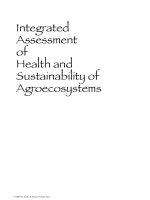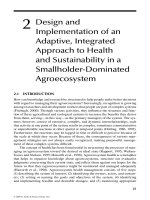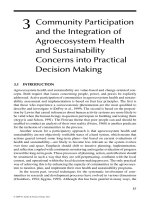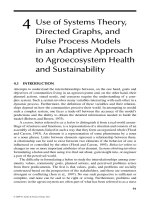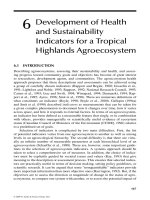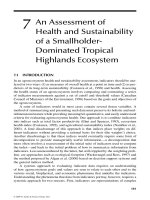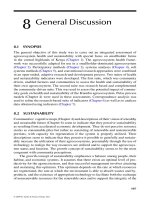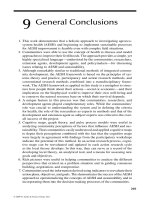Integrated Assessment of Health and Sustainability of Agroecosystems - Chapter 8 docx
Bạn đang xem bản rút gọn của tài liệu. Xem và tải ngay bản đầy đủ của tài liệu tại đây (267.97 KB, 5 trang )
197
8
General Discussion
8.1 synoPsIs
The general objective of this study was to carry out an integrated assessment of
agroecosystem health and sustainability with special focus on smallholder farms
in the central highlands of Kenya (Chapter 1). The agroecosystem health frame-
work was successfully adapted for use in a smallholder-dominated agroecosystem
(Chapter 2). Participatory methods (Chapter 3), systems analyses (Chapter 4), soft
systems methods (Chapter 5), and conventional research approaches were combined
in an open-ended, adaptive research-and-development process. Two suites of health
and sustainability indicators were developed. The rst suite, which was community
driven, enabled farmers and communities to assess the health and sustainability of
their own agroecosystem. The second suite was research based and complemented
the community-driven suite. This was used to assess the potential impact of commu-
nity goals on health and sustainability of the Kiambu agroecosystem. Pulse process
models (Chapter 4) were used in these assessments. Correspondence analysis was
used to rene the research-based suite of indicators (Chapter 6) as well as to analyze
data obtained using indicators (Chapter 7).
8.2 sustaInabIlIty
Communities’ cognitive maps (Chapter 4) and descriptions of their vision of a healthy
and sustainable future (Chapter 6) seem to indicate that they perceive sustainability
as resulting from accelerated economic development. They do not perceive resource
stocks as consumable piles but rather as consisting of renewable and nonrenewable
portions, with capacity for regeneration if the system is properly utilized. Their
descriptions seem to indicate that they perceive it possible to gainfully and sustain-
ably increase the utilization of their agroecosystems, presumably through the use of
technology to realign the way resources are utilized and to support the agroecosys-
tem status and function. The growth concept of sustainability seems to be the most
congruent with community perceptions.
The growth concept of sustainability emphasizes a balance among people, their
habitat, and economic systems. It assumes that there exists an optimal level of pro-
ductivity for the agroecosystem, and that successful management involves attaining
and sustaining this optimum. This optimum depends on the rate at which resources
are regenerated, the rate at which the environment is able to absorb wastes and by-
products, and the existence of appropriate technology to facilitate both the exchange
of nonrenewable resources for the renewable ones and to support the integrity of the
© 2009 by Taylor & Francis Group, LLC
198 Integrated Assessment of Health and Sustainability of Agroecosystems
agroecosystem. That communities perceive this to be the case is illustrated by their
recognition of the need to enhance both productivity and soil quality through use of
manure. Another example is where they attempt to optimize the use of agrochemicals
to increase productivity but minimize their perceived negative health impacts on the
community.
Communities showed great concern for sustainability issues and had a clear-
cut idea of what it meant (Chapter 6) in their own agroecosystem despite its vague
and ambiguous denition. This underscores the global appeal of the sustainability
concept and its power in stimulating debate on natural resource husbandry. Like
the concept of health, sustainability—it seems—is capable of being operationalized
without the need for further renement of its denition. It is probable that rene-
ment, which implies dilution of its holistic connotation, may result in the loss of its
global appeal and therefore its potential to evoke and guide the need for change in
natural resource management.
Although communities have a strong sense of what is good and what is bad in
terms of the health and sustainability of their agroecosystems (evidenced in their
problem analysis; Chapter 3), they did not seem to appreciate the need for—or lacked
a capacity for—debating, negotiating, planning, and implementing remedial actions
(Chapter 5). Based on their approach in selecting indicators (Chapter 6), sustainable
development, to them, implied stating long-term goals for the agroecosystem and
then building and evaluating short-term and long-term goals based on these. From
their perspective, a sustainability assessment involves an evaluation of the proba-
bilities that the desired long-term goals will be attained given the current manage-
ment practices and agroecosystem conditions. In system terms, this implies that the
agroecosystem together with its socioeconomic subsystems must form a holon with
integrity, that is, the emergent property of a holon to regulate and organize its own
internal structure and function and to mitigate stresses imposed from the outside so
that it can perpetuate itself over all foreseeable external uctuations. A key require-
ment for integrity is the existence of monitoring and control subunits within the
holon, which in turn implies the existence of at least one measure of performance, a
criterion of what constitutes good or bad performance, and the remedial action to be
taken for each of the possible outcomes. The inability of communities to pursue col-
lective goals, when contrasted with the communities’ demand for action subsequent
to the initial village workshops, gives validity to this analysis. The request by com-
munities to form village agroecosystem health committees can be interpreted as an
attempt to build monitoring and control structures.
8.3 aGRoecosystem HealtH
While the concept of sustainability evokes notions of natural resource husbandry,
the agroecosystem health paradigm provides a compelling framework for the suc-
cessful management of agricultural and ecological systems. Community members,
extension agents, and policymakers in this project used concepts derived from the
health disciplines to assess and set goals for their agroecosystem; to debate, negoti-
ate, and plan remedial measures; and then to monitor and evaluate progress. In this
regard, sustainability was seen as analogous to health in the sense that they are both
© 2009 by Taylor & Francis Group, LLC
General Discussion 199
objectively denable states of dynamic systems that, once described, can be effec-
tively pursued.
Based on the type of indicators selected by communities, it seems that com-
munities perceived agroecosystem health from a tness assessment rather than a
diagnostic perspective. In the latter perspective, the objective of the process is to
discover and characterize pathological processes and the risk factors associated with
them. The former focuses on the capabilities of the system and what enhances it.
Based on this perspective, the key health attributes are productivity, vigor, resilience,
equitability, stability, and integrity. The objective of an agroecosystem health assess-
ment is to understand how the system can achieve and sustain desired community
outcomes. In contrast, the objectives based on a diagnostic perspective would be
to discover potential risk factors to the attainment of community goals. Important
attributes in this case would include equitability, elasticity, inertia, and vulnerability.
While the tness assessment perspective was used by the communities to help them
set reasonable goals for their system, ignoring the diagnostic perspective resulted in
failure of community action plans after a signicant amount of resources had been
expended, resulting in a lot of frustration and decline in the communities’ capacity
for collective action.
Communities were able to develop a reasonably parsimonious suite of indica-
tors. This is at odds with the assertion that ecosystems present an almost-innite
list of potential indicators. This assertion stems from models of agroecosystems
as dynamic states of a hard system. In contrast, communities and researchers in
this project modeled agroecosystems as problem-based soft systems. Indeed, ques-
tions of sustainability and health would have little relevance in systems that do not
include some components of human inuence. The question of sustainability implies
a human activity system and an existence of a complex problem situation. Building
problem-based models of agroecosystems limits the choice of indicators to those
related to the subsystems in which the problems occur and are manifest. Building
problem-based models requires experiential knowledge of the system, emphasizing
the importance of community knowledge of their agroecosystem.
8.4 KIambu aGRoecosystem
Scarcity of farmland is an important determinant of the nature of smallholder agri-
culture in Kiambu. This is evidenced by the differences in agricultural practices
and productivity among the six villages (Chapter 2). The availability of markets and
demand for produce are other important issues, as evidenced by the abandonment of
recommended farm enterprises (based on agroecological suitability), such as coffee
and tea production in Mahindi and Kiawamgira and sheep production in Thiririka,
for those that are largely market driven, such as dairy and vegetable production.
While these trends indicate adaptability in a general sense, they could also be reec-
tive of some kind of instability in the system given the relatively short time span over
which they are occurring. More important, these communities seem to have a high
degree of adaptability regarding the kind of farm enterprises in which they are will-
ing to engage, and their farming decisions appear to be linked to market availability,
indicating a high degree of effectiveness.
© 2009 by Taylor & Francis Group, LLC
200 Integrated Assessment of Health and Sustainability of Agroecosystems
Although, on average, income for a household was low, many of the households
had diverse sources of income, including off-farm employment. It was difcult to
assess the relative stability of these incomes, but it can be assumed that the diver-
sication observed is an attempt to minimize risk. On the other hand, there was an
oversupply of labor in most of the households, and the diversication may be simply
a consequence of this. Interestingly, communities perceived labor as one of the prod-
ucts they export. This was not seen as competing with demands for agricultural pro-
duction except in Gikabu village, where demand for casual labor in the neighboring
tea estates was seen to be in direct conict with the needs for smallholder tea produc-
tion. Another interesting aspect was that although communities saw a direct relation-
ship between education/knowledge/skills and access to off-farm employment, they
did not appreciate the value of off-farm employment as resulting in increasing com-
munity contact with the outside world and as a source of knowledge and information.
It is likely that this is the mechanism through which the villages obtain the critical
information that has facilitated their adaptation to changing circumstances.
8.5 HealtH and sustaInabIlIty assessment
In general, the agroecosystem approach has many attractions from both the research
and development perspectives. The health paradigm used is easily understood and
conceptually facilitates the diagnosis, treatment, follow-up monitoring, and evalua-
tion of agroecosystems. Because health assessments are value laden, their establish-
ment requires community participation if they are to achieve meaningful and lasting
results. In addition, analyses at different holarchical scales are helpful for commu-
nities since development requires cooperation across households and villages and
larger levels of organization, such as government and other agencies. A key feature
of the process is that community organization—manifest as a capacity for collective
action—is both a prerequisite and an outcome of the process. While communities
with less capacity for action will realize minimal impacts in the short term, the long-
term effects will be increased organization—setting the stage for better outcomes in
the future.
There are a number of practical implications noted during the project. The rst
was that this research paradigm allows for the development of an effective forum
for community and research collaboration. The second was that integrating par-
ticipatory and standard research approaches to address community concerns can
achieve tangible results. The research input helped communities to better understand
the choices to be made in developing and modifying community action plans. For
researchers, there were real benets from communities generating research ques-
tions based on the real needs of the community. Research results, in this context,
are more likely to be adopted and sustained. Furthermore, the various processes and
steps of the framework increase community awareness, self-knowledge, and analyti-
cal skills. This, together with the enhanced capacity for action, increases their ability
to adapt and hence improve their health.
The main difculties in the agroecosystem approach are related to its time hori-
zon and location specicity. As the process is open ended, only its initiation and early
© 2009 by Taylor & Francis Group, LLC
General Discussion 201
development t into a standard project time frame. Longer-term issues, such as clear-
cut assessments of sustainability, require longer-term monitoring mechanisms. It is
difcult to judge how lessons learned in one set of communities can be generalized
to other communities and agroecosystems. In our view, the process is transferable
with fairly moderate adaptive changes. Some of the lessons may be instructive in the
management and assessment of similar agroecosystems, but this will become clear
as more studies of this nature are undertaken, compared, and contrasted.
The holistic approach adopted in this process, while essential to establish the
crucial context for decisions and priorities, means that researchers and development
agents with narrowly dened terms of reference will not be able or willing to use this
approach, especially if their priorities are not strongly linked with those of the target
communities. Agroecosystem health assessments can be initiated under the umbrella
of agencies (such as the National Agricultural Research Service [NARS]) that have
broader terms of reference, while those with narrower focus are best integrated in a
secondary process based on the outcomes of the initial assessments and analyses.
The key lesson for communities is that the health approach to community descrip-
tion, problem analysis, and action planning only works if the community is commit-
ted to and leads the process. All communities had some success with this approach,
mainly related to their organizational ability and commitment. The participatory
techniques for analyzing, planning, and monitoring action plans were effective and
contributed to community mobilization and action. Communities also discovered
that they could learn effectively from the experiences of other communities. Thus,
strategies to foster intervillage collaboration need to be an important feature of such
efforts. Researchers from all disciplines involved in this project appreciated the abil-
ity of communities to formulate “research” questions and analyze constraints. This
approach provides an important pathway for developing relevant research questions.
In addition, the perspective and ability of communities to analyze their problems
were impressive and can be an important tool for researchers trying to assess com-
plex issues using soft systems and more traditional multivariate approaches.
8.6 summaRy
The increasing realization that human activities have complex impacts on the health
and sustainability of agricultural and ecological systems has led to the increasing
interest in holistic and adaptive approaches in the management of human activity
systems. The results presented in this study strongly illustrate that such holistic
approaches are feasible and demonstrate the potential of the agroecosystem health
paradigm as a framework for incorporating these concerns into the decision-making
processes of agricultural communities in a tropical highlands agroecosystem.
© 2009 by Taylor & Francis Group, LLC
